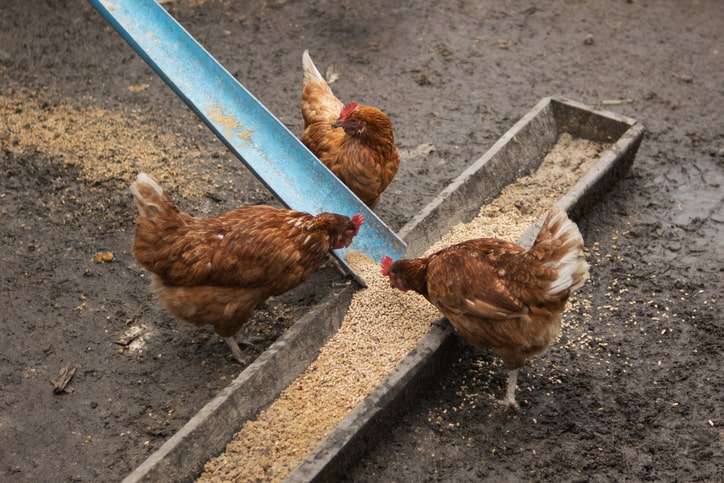
Every Type of Chicken Feed Explained
When you’re starting to raise chickens, figuring out what feed is best for them can be a bit intimidating. Fortunately, there is a feed specifically designed for every stage of a chicken’s life cycle. With this guide, you’ll never feel lost trying to figure out what chicken feed to use again.
Before we get started on all the different types of chicken feed, here are the three textures chicken feed is available in:
- Mash: With a soft, soil-like texture, mash is easily digestible and can be fed to all ages, from chicks to full-grown hens. Mash can be combined with hot water to create a porridge-style treat that will keep your flock full and happy in the winter. Because mash is easy to spill, though, it has the most waste of any type of chicken feed.
- Crumble: This feed has an oatmeal-like texture that provides more crunch to keep your flock satisfied. Many chicken farmers claim that crumble is the preferred food texture of their chickens, especially compared to pellets. However, crumble is also easy to spill and can lead to food waste.
- Pellets: The compact nature of pellets means that this feed is pretty much spill-proof. Even if your flock knocks over these cylinder-shaped pellets, they will still hold their shape and be completely edible.
What Are the Different Types of Chicken Feed?
The best type of feed for your chickens can vary based on their age and a few other factors. Your options include the following varieties:
Chick Starter/Grower Crumbles
For the first six weeks of their life, chicks can be fed chick starter/grower crumbles and water exclusively. The easily digestible texture combined with extra protein will help your chicks grow into healthy adults. However, the high protein content can damage your chicks’ livers once they become too old, so don’t feed them starter after the recommended time period. Our 18% Organic Chick Starter/Grower Crumble will give your birds a healthy life start until their first eggs are laid!
Layer Rations
Once your birds have reached the age of 20 to 22 weeks, they should be at egg-laying maturity. Hens should be kept on a diet of 16% protein feed with supplemental calcium to keep their shells hardy and robust. Our 16% Egg Layer Crumbles and 16% Egg Layer Pellets will keep your hens full with plenty of vitamins, minerals, proteins and amino acids.
It is important to note that chickens of different ages should be kept in separate spaces. Chicks will eat any food put in front of them, and the high protein or calcium of certain feeds can hurt the kidneys or livers of chicks that are too young or too old for that feed. Layer rations can be fed to hens and broilers, but not chicks.
Oyster or Shell Grit
Grit is an essential supplementary component to your flock’s feed. As another source of calcium, shell grit keeps your hens laying hardy eggs and prevents mature hens from laying misshapen eggs. But it’s not just hens that need grit in their diet! Chickens store shell grit in their gizzards to help them pulverize food, especially rougher, textured food like pellets and poultry scratch grains. Since chickens have no teeth, they need this grit to help break down large pieces of food.
Chicken Scratch
Chicken scratch consists of crunchy foods like corn and seeds that birds love to snack on. On cold nights when birds need to stay warm, chicken scratch can also just be a tasty treat. Scratch shouldn’t be the cornerstone of your flock’s diet, though. Think of chicken scratch as junk food or a snack. It’s great in moderation and a fun surprise every once in a while, but birds can’t survive on just poultry scratch.
Scratch should never make up more than 10% of your chicken’s diet to keep them healthy and lean. But when you are ready to treat your flock, our Organic Poultry Scratch Gains with corn and seeds is sure to satisfy.
Fermented Feed
With fermented feed, you can keep your chickens fuller longer while increasing their vitamin and enzyme intake. Fermented feed is easier for your flock to digest. It neutralizes toxicity and leaves your coop cleaner with fewer droppings. To learn how to ferment your own chicken feed, check out our previous blog!
Feed Your Flock Nature’s Best Organic Chicken Feed
Whether you’re just starting chicken farming or are looking to switch over to a natural organic feed, Nature’s Best has the feed your flock needs. With almost 75 years of experience, Nature’s Best Organic Feeds will provide you with tried and true organic feed, available in both bagged and bulk quantities. Each of our feeds is formulated by nutrition experts to ensure your birds grow up healthy and strong!
To browse our complete selection of Nature’s Best Organic Chicken Feeds and learn more about different types of feed, head on over to our product page and keep an eye on this blog!